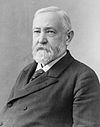Front porch campaign

A front porch campaign is a low-key electoral campaign used in American politics in which the candidate remains close to or at home where they issue written statements and give speeches to supporters who come to visit. The candidate largely does not travel around or otherwise actively campaign. The presidential campaigns of James A. Garfield in 1880, Benjamin Harrison in 1888, William McKinley, and Warren G. Harding are perhaps the best-known front porch campaigns.
McKinley campaign
[edit]
McKinley's opposing candidate, William Jennings Bryan, gave over 600 speeches and traveled many miles all over the United States to campaign, but McKinley outdid this by spending about twice as much money campaigning. While McKinley was at his Canton, Ohio, home conducting his "front-porch campaign", Mark Hanna was out raising millions to help with the campaign. Hanna also arranged for various delegations to visit McKinley and hear him deliver a short speech that would then be circulated by the newspapers. These delegations were made up of various interest and demographic groups.
Throughout the course of the 1896 United States presidential election, William McKinley spoke to more than 700,000 supporters in front of his house in Canton. These speeches started as organized meetings between McKinley and delegations from all over the nation. Although it was expensive for the campaign to bring these delegations, all in all, this idea became a good strategy because of the publicity it generated. In addition, due to the fact that McKinley's campaign chose those who would travel as part of the delegation, it was possible to make those who spoke portray McKinley positively.
Whistle Stop Train Tour
[edit]McKinley's front-porch campaign was a big contrast to William Jennings Bryan's unprecedented whistle-stop train tour throughout the United States. A 2022 study used these different campaigning strategies to assess the impact of campaign visits. The study found that "campaign visits by Bryan increased his vote share by about one percentage point on average."
Warren G. Harding
[edit]Another president known for his front porch campaign was Warren G. Harding during the presidential election of 1920. Harding was a republican who opposed the sitting president Woodrow Wilson's handling of World War 1 and the decisions of the League of Nations.[1] He supported new immigration and trades laws using this to push his idea of a promise of return to normal times.[1] Socially he fought to end lynching and offered support for woman suffrage. He ran against liberal democrat James M. Cox. Cox supported Wilson and planned to continue his progressive idealistic narrative in his term. At his home in Marion, Indiana, Harding used a front porch campaign strategy in this race where he spoke with cliche phrases to display his narrative of returning the country to normal.[1] This led to Harding winning the presidential election by a landslide collecting 404 electoral votes to Cox's 127. Harding died from a heart attack within his first term on August 2, 1923, leaving Vice President Calvin Coolidge to take over.
James A. Garfield
[edit]James A. Garfield was the republican nomination for the 1880 presidential election. He ran against the democrat's nominee Winfield Scott Hancock. Garfield won the close election by less than 10,000 votes.[2] In Mentor, Ohio, Garfield stayed at home honoring campaigning traditions at the time that emulated George Washington's presidency.[3] James gave out short speeches on his front lawn where he spoke about the "The future of colored men", "The possibilities of life", " The immorality of ideas", and "German citizens".[4]
During this time the republican party was split up into two different groups, the Stalwarts and the Half-Breeds. The Stalwarts were more conservative while the Half-Breeds were more progressive. Garfield had to tend to both sides of his party and did so by appointing James G. Blaine (Half-Breed) as his secretary of state and the Half-Breed's with other significant post.[2] The Stalwarts felt like they had been underrepresented, which inevitably lead to the assassination of Garfield on July 2, 1881. Charles Guiteau was responsible, after which he exclaimed "I am a Stalwart and Arthur is president now!".[2] Guiteau was charged and later hung for his crimes in 1882.[2]
Benjamin Harrison
[edit]Benjamin Harrison took inspiration from Garfield and ran his own front porch campaign in Indianapolis in 1889. During this time over 350,000 people came to visit his home, many offering gifts.[5] Harrison gave speeches which spoke of highly protected tariffs along with offering support to union soldiers.[5] He gained a huge support from soldiers who sought protection of their homes and family. During this time the infamous Jim Crow Laws were being set in place. To combat, Harrison hosted many African Americans to which he pledged to protect their rights.[5] Harrison went on to win the presidential election with 233 electoral votes despite Grover Cleveland winning the popular vote with only 168 electoral votes.[6]
References
[edit]- ^ a b c "Warren G. Harding: Campaigns and Elections | Miller Center". millercenter.org. October 4, 2016. Retrieved December 14, 2024.
- ^ a b c d "James A. Garfield ‑ Assassination, Presidency & Facts". HISTORY. June 10, 2019. Retrieved December 14, 2024.
- ^ "The Front Porch Campaign of 1880 (U.S. National Park Service)". www.nps.gov. Retrieved December 14, 2024.
- ^ "The Front Porch Campaign of 1880 (U.S. National Park Service)". www.nps.gov. Retrieved December 14, 2024.
- ^ a b c Network, Jeffrey Normand Bourdon / History News (February 10, 2020). "Today's Presidential Candidates Go Where the Voters Are—But These Past Campaigns Succeeded by Bringing the Voters to the Candidates". TIME. Retrieved December 14, 2024.
- ^ "The Election of 1888", The Routledge Historical Atlas of Presidential Elections (0 ed.), Routledge, pp. 71–72, December 16, 2013, doi:10.4324/9780203949627-29, ISBN 978-0-203-94962-7, retrieved December 14, 2024
External links
[edit]- A Front-Porch Campaign for Citizen Dole. (May 22, 1996)
- Front-porch campaign: You and the candidate – and 30 cameras. (July 19, 2004)
- Kerry announces Front Porch offensive. (September 2, 2004)
- Back-porch politics in 5th District race. (July 16, 2007)



